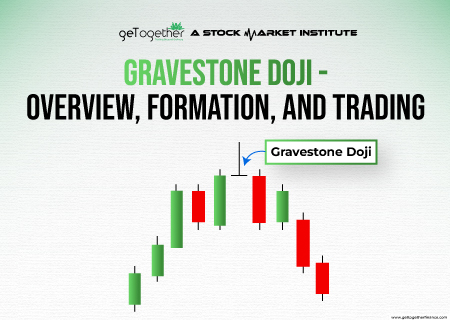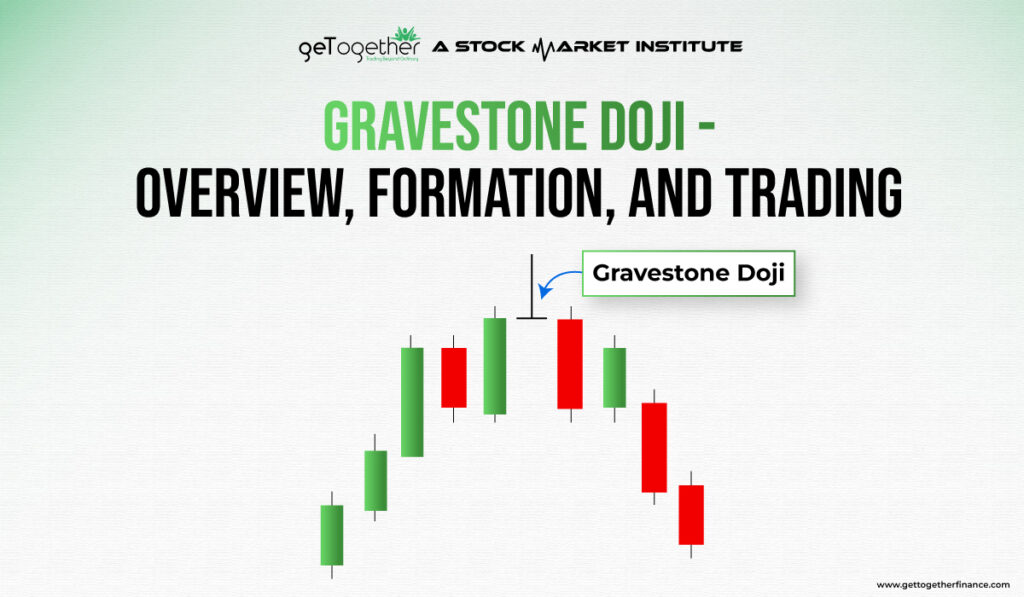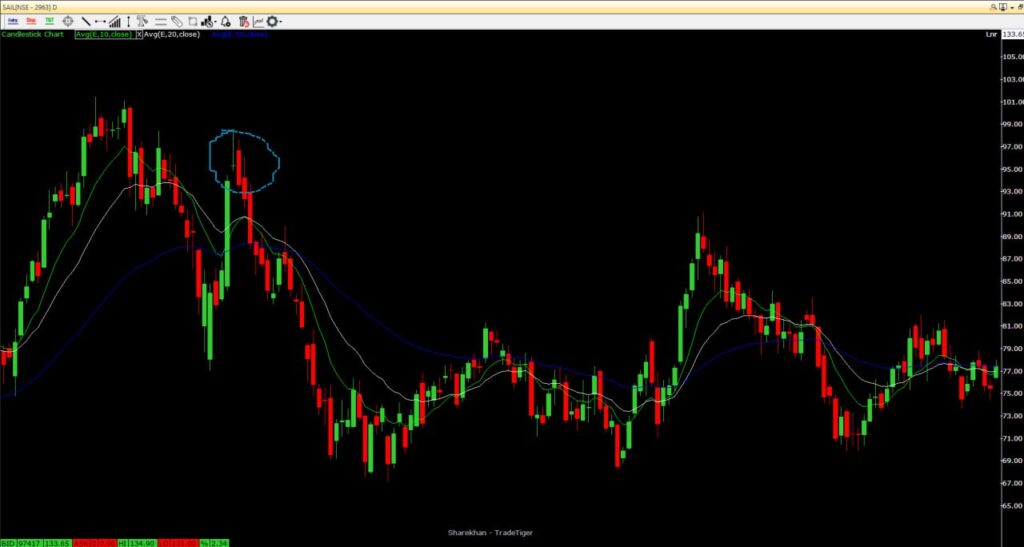Gravestone Doji – Overview, Formation, and Trading


The Gravestone Doji is a candlestick pattern frequently used in technical analysis to identify potential trend reversals in financial markets. It is considered a bearish reversal pattern and is characterized by a long upper shadow, a small or non-existent body, and little to no lower shadow. The name “Gravestone Doji” is derived from its resemblance to an upright gravestone.
What Is a Gravestone Doji?
The gravestone doji is a candlestick pattern commonly used in technical analysis to identify potential trend reversals in financial markets. It is characterized by a specific candlestick shape that resembles a gravestone standing upright, hence the name.
Gravestone Doji Candlestick Pattern Overview
The gravestone doji candlestick pattern is formed when the open, high, and closing prices are all at or near the same level, typically at the low of the trading period. This creates a long upper shadow, or wick, and little to no lower shadow. The pattern suggests that buyers initially pushed the price higher but were unable to maintain control, resulting in a potential shift in market sentiment.
How is the Gravestone Doji Candlestick Pattern Formed?

The formation of a gravestone doji candlestick pattern requires specific price action. During the trading period, buyers push the price higher, but eventually, sellers take control and drive the price back down to or near the opening level. This creates a long upper shadow and a small or non-existent lower shadow, forming the distinctive shape of a gravestone doji.
The formation of a gravestone doji suggests a potential reversal in market sentiment. It occurs when buyers initially push the price higher but are unable to maintain control, resulting in sellers stepping in and pushing the price back down.
Trading the Gravestone Doji
Traders often look for confirmation signals to validate the gravestone doji pattern before making trading decisions. These signals can include additional technical indicators, such as moving averages, trendlines, or oscillators, that support the potential reversal indicated by the gravestone doji. Volume analysis is also important, as an increase in trading volume accompanying the pattern can provide further confirmation.
When trading the gravestone doji, it’s crucial to consider the overall market context. Factors such as the prevailing trend, key support and resistance levels, and the presence of other chart patterns can significantly impact the pattern’s effectiveness. Additionally, risk management techniques, including setting appropriate stop loss and take profit levels, are essential to protect against potential losses.
While the gravestone doji can be a useful tool in technical analysis, it’s important to note its limitations. False signals can occur, as with any pattern or indicator, so it’s advisable to use additional confirmation tools. Market context should also be taken into account, as the gravestone doji’s effectiveness can vary depending on the overall market conditions.
The gravestone doji is considered a bearish reversal pattern, suggesting a potential change in the prevailing uptrend. Traders often look for confirmation signals before making trading decisions based on this pattern.
Also Read: Doji Candlestick
Here are to consider when trading the gravestone doji:

Confirmation: Wait for confirmation from additional technical indicators or candlestick patterns before entering a trade. This can help reduce false signals and increase the probability of a successful trade.
Support and Resistance: Identify key support and resistance levels on the price chart. If a gravestone doji forms near a significant resistance level, it may indicate a higher probability of a trend reversal.
Volume Analysis: Analyze trading volume accompanying the formation of the gravestone doji. An increase in volume can validate the pattern and provide further confirmation of a potential trend reversal.
Stop Loss and Take Profit Levels: Determine appropriate stop loss and take profit levels based on the price action and your risk tolerance. Placing a stop loss above the high of the gravestone doji can help limit potential losses if the pattern fails.
The Different Types of Doji Patterns
Doji patterns are characterized by their shape, where the opening and closing prices are close to each other, resulting in a small body. Besides the gravestone doji, there are other common types of doji patterns, including:
- Dragonfly Doji: It has a long lower shadow and no upper shadow, resembling an inverted T.
- Long-Legged Doji: It has long upper and lower shadows, indicating indecision and potential market reversal.
- Four Price Doji: It occurs when the opening, closing, high, and low prices are all the same, resulting in a small cross-shaped candlestick.
Examples of Gravestone Doji
Here are a few examples of gravestone doji patterns in different financial markets:
Example: Sail

In a daily chart of sail, the price opens at 95.35. It then rallies to a high of 98.30 but encounters selling pressure and closes near the opening price at 95.35. The low of the day is 94.90. The resulting candlestick has a long upper shadow, a small body, and little to no lower shadow, resembling a Gravestone Doji. This pattern indicates potential bearish reversal signals.
Limitations of the Gravestone Doji

While the gravestone doji can provide valuable insights into potential trend reversals, it is essential to consider its limitations:
- False Signals: Like any technical indicator or pattern, the gravestone doji is not foolproof and can produce false signals. It is crucial to use additional confirmation tools and indicators to increase the reliability of the pattern.
- Market Context: The gravestone doji should be analyzed within the broader market context. Factors such as overall trend, volume, and support/resistance levels can significantly impact the pattern’s effectiveness.
Analyzing the overall market context is crucial when considering the gravestone doji pattern. Here are some tips to help you assess the broader market conditions:
- Trend Analysis: Determine the prevailing trend in the market. Is it an uptrend, downtrend, or a sideways trend? The gravestone doji pattern is typically more meaningful when it occurs within the context of an established trend. If the gravestone doji forms against the prevailing trend, it may carry more significance as a potential reversal signal.
- Support and Resistance Levels: Identify key support and resistance levels on the price chart. The gravestone doji pattern near a significant resistance level can indicate a higher probability of a trend reversal. Conversely, a gravestone doji near a strong support level might suggest a potential bounce or continuation of the existing trend.
- Volume Analysis: Pay attention to the trading volume accompanying the formation of the gravestone doji. An increase in volume during the formation of the pattern can provide further confirmation of a potential trend reversal. Higher volume suggests increased market participation and strengthens the significance of the pattern.
- Other Technical Indicators: Utilize other technical indicators to support your analysis. For example, you can examine oscillators like the Relative Strength Index (RSI) or the Moving Average Convergence Divergence (MACD) to identify overbought or oversold conditions. If these indicators align with the gravestone doji’s bearish reversal signal, it strengthens the overall analysis.
- Timeframe Consideration: Analyze the gravestone doji pattern within different timeframes to gain a broader perspective. A gravestone doji on a shorter timeframe (e.g., intraday chart) may have a different significance compared to the same pattern on a longer timeframe (e.g., daily or weekly chart). Consider the relationship between these different timeframes to validate the pattern’s importance.
- Market Sentiment: Assess the overall sentiment in the market. Are investors generally optimistic or pessimistic? This can be determined by monitoring news, economic indicators, and the behavior of market participants. If the gravestone doji pattern aligns with a shift in sentiment, it can carry greater significance.
- Market Structure: Evaluate the structure of the market. Is it displaying clear patterns or is it choppy and unpredictable? The effectiveness of the gravestone doji pattern can vary depending on the market structure. In well-defined trends or chart patterns, the pattern may have stronger predictive power.
- Correlation with Other Assets: Consider the correlation between the asset displaying the gravestone doji pattern and other related assets or markets. For example, if you’re analyzing a stock, examine the performance of the broader market index or sector it belongs to. If the pattern aligns with weakness in correlated assets, it adds further weight to the potential reversal scenario.
- Fundamental Analysis: Combine technical analysis with fundamental analysis. Consider the underlying factors that may be driving the market. Earnings reports, economic data, geopolitical events, and central bank policies can all influence market sentiment. If the gravestone doji pattern aligns with fundamental factors pointing towards a reversal, it strengthens the analysis.
- Historical Performance: Study the historical performance of the gravestone doji pattern in the specific market or asset you are analyzing. Look for past instances where the pattern occurred and observe how the market reacted afterward. This can provide insights into the pattern’s reliability and help you gauge its potential effectiveness.
It’s crucial to use the gravestone doji pattern as part of a comprehensive analysis, incorporating other technical tools, market context, and risk management strategies. By combining multiple factors, you can make more informed trading decisions and reduce the risk of false signals.
Conclusion
The gravestone doji is a candlestick pattern that can provide valuable insights into potential trend reversals. Traders use this pattern in combination with other technical tools and indicators to make informed trading decisions. However, it is essential to consider the pattern within the broader market context and to use proper risk management techniques when implementing trading strategies based on the gravestone doji pattern.
FAQ
Is a Doji bullish or bearish?
A doji candlestick pattern alone doesn’t indicate a specific bullish or bearish bias. It represents market indecision and suggests a potential trend reversal or continuation, depending on the context and subsequent price action.
Can a Gravestone Doji be bullish?
No, a gravestone doji is considered a bearish reversal pattern. It suggests that buyers initially pushed the price higher but failed to maintain control, indicating a potential shift in sentiment from bullish to bearish.
What is the meaning of Doji on a gravestone?
The presence of a Doji on a gravestone pattern signifies market indecision and potential trend reversal. It indicates that despite initial buying pressure, sellers were able to push the price back down, resulting in a long upper shadow and little to no lower shadow.
What is the best way to trade a gravestone Doji?
When trading a gravestone doji, it is crucial to wait for confirmation signals before taking any action. This can include additional technical indicators, candlestick patterns, or shifts in trading volume. It is also advisable to consider the overall market context, support and resistance levels, and risk management techniques such as setting appropriate stop loss and take profit levels.
What is the Gravestone Doji with Gap-up?
A gravestone doji with a gap-up occurs when the opening price of the trading period is significantly higher than the previous closing price, creating a gap on the price chart. The gravestone doji pattern is then formed as the price retraces from the opening level, resulting in a long upper shadow and a small or non-existent lower shadow. This pattern suggests a potential exhaustion of buying pressure and a higher likelihood of a trend reversal.



 Facebook
Facebook  Instagram
Instagram  Youtube
Youtube 
